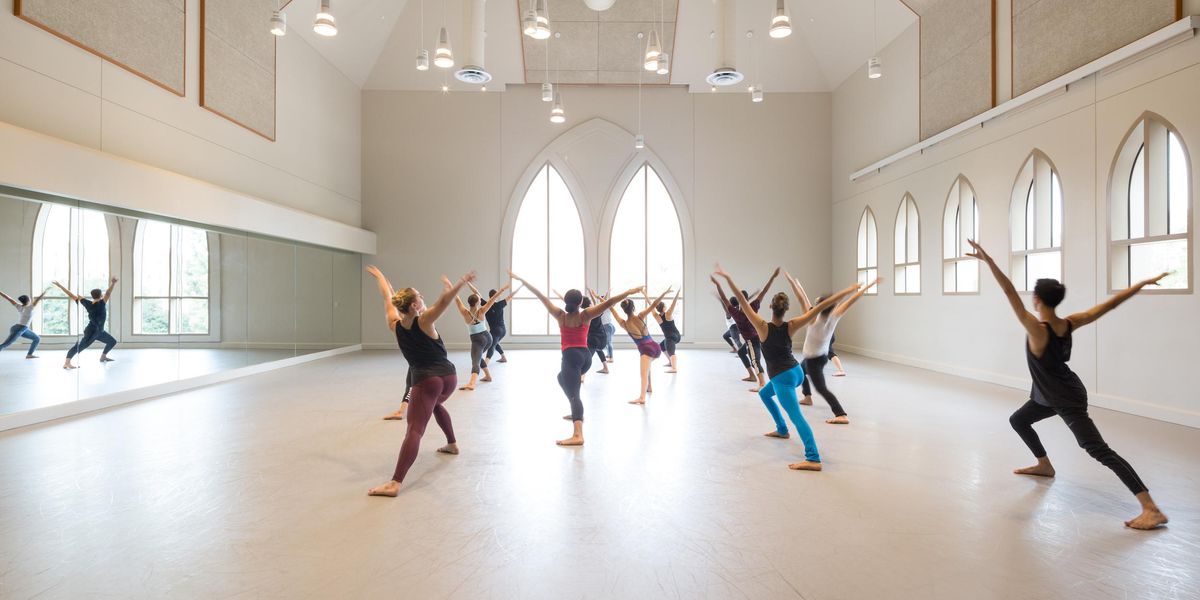Trading Pliés for Popping, Locking and Breaking
What street styles can do for concert dancers
Popping and locking can help you learn to relax your upper body. Here: Val “Ms. Vee” Ho’s class at Broadway Dance Center. Photo by Sandy Shelton, courtesy Broadway Dance Center.
Marquisa Gardner spent the first 17 years of her life training in ballet, jazz and tap. In college, she began performing with a contemporary ballet company and teaching jazz classes in Los Angeles. Then one of her students brought her to a club where kids were dancing a style called clowning. “It was a major culture shock for me,” Gardner says. “I tried to mimic what the dancers were doing, but I was rooted with ballet technique.”
She was hooked, though. Exploring the new style helped Gardner improve her performance quality, and gave her a new outlet for expressing herself. Today Gardner is “Miss Prissy,” known as the Queen of Krump and one of the stars of the 2005 film
Rize.
Though it can be tempting to stay in your comfort zone, trying different street dance styles could be the key to your versatility: You’ll begin to hear music differently, find new ways to move and expand your improvisation skills. Unsure about which to dive into first? Read on for a breakdown.
B-Boying: Improve Floor Work, Get Faster Feet and Learn Flashy Tricks
The first step to channeling your inner b-girl: Get comfortable getting fast and low. B-boying, sometimes referred to as breaking or break dancing, utilizes floor work (think head and knee spins), freezes, acrobatic elements and quick footwork. “It’s a physical style—you’re going to be on your hands a lot,” says Alex Welch, aka “B-Girl Shorty,” a Los Angeles–based instructor and member of the Beat Freaks.
As with many street styles, b-boying relies heavily on freestyling, so learning to let go is key. Nothing b-girls do is small—the movements are precise but explosive. Most of all? “A b-girl is strong, independent and kills it every time,” says Welch. “She never lets anyone tell her she can’t do something.”
Popping and Locking: Master Intricacies and Details
While the East Coast was break-dancing during the 1970s, funk styles—like popping and locking—were cropping up on the West Coast. Val “Ms. Vee” Ho, an instructor at Broadway Dance Center, Peridance and Pace University’s commercial dance program, explains locking as “quick, sharp, dynamic movements,” while popping is “a quick contraction of the muscle followed by an immediate relaxation.” Popping is a smaller, repetitive motion, while locking is a bigger, more external way of dancing. “Locking is swinging with the beat,” Ho says. “Popping is attacking the beat.”
Both styles require classically trained dancers to relax their spines. “Instead of thinking
up, up, up, fighting gravity and balancing, think about dancing down,” Ho says. “The funk styles work with gravity instead of against it. The biggest struggle many concert dancers face is relaxing their neck and upper back.” Learning to maintain a balance between technique and release makes for a more interesting dancer.
Krumping: Develop an Explosive, Full-Bodied Performance
Although krumping has gained popularity thanks to “So You Think You Can Dance,” the televised version is slightly watered down. Krumping is almost entirely freestyle and rarely choreographed. It is a battle-centric style more than a stage style, and it’s one of the most aggressive forms of street dance. Instead of focusing on floor work and tricks, krumpers dance upright, with explosive arms, bent knees and pulsing chests. “Krumping is a fusion of African cultural dance and street dance,” says Gardner.
It’s crucial to fully abandon your concert dance roots in order to best explore the style. When Gardner first tried krump, her ballet training hindered her. “I couldn’t create the lines and embrace the dynamic,” she says. “With krump, you’re not trying to achieve a perfect arabesque. It’s about being raw and telling a story. You can be passionate and vibrant, and it should feel amazing. There’s no wrong way to krump.”
Having a hard time? “Give yourself scenarios,” Gardner says. “How would you feel if your boyfriend broke up with you? How do you channel your aggression? What about your passion? Express that energy in your freestyle.”
Voguing: Gain Cleaner Lines and a More Dramatic Presence
Imagine someone is taking a photo of every move you hit throughout a piece of choreography. That’s voguing. The form is about looking linear and angular to create shapes with your body. It’s precision-based, but requires dancers to maintain a fluid, graceful posture, while creating a dramatic picture with every movement.
Javier Madrid, known as “Javier Ninja,” says the key to immersing yourself in vogue choreography is to worry less about your lines and more about rhythm and confidence. “You can’t be timid. No one wants to watch a shy dancer,” he says. Envision yourself as a model in a magazine. “They look extended, like there’s a line down their backs. They’re dainty, but dramatic.” Madrid says everything vogue dancers do can be directly applied back to concert styles: “Your lines will become cleaner, you’ll look taller, more elegant—and you won’t do anything halfway ever again.”




